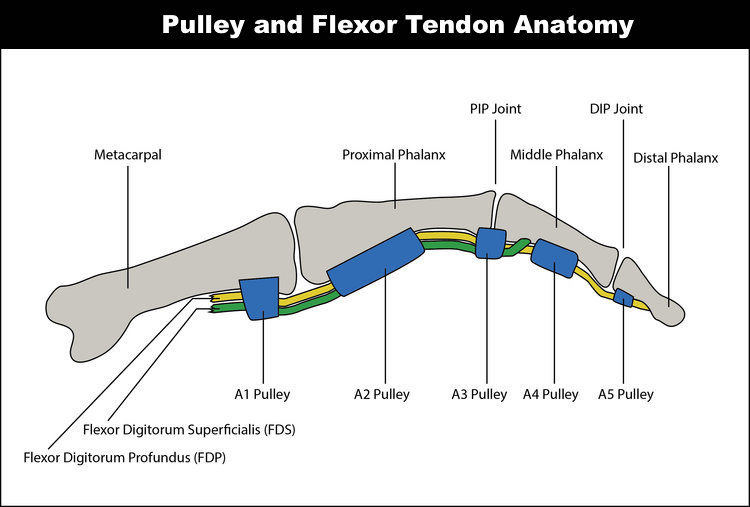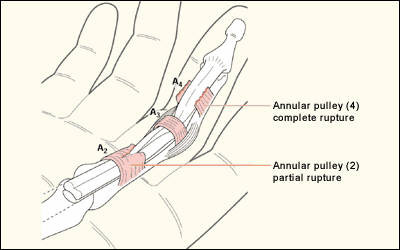Climbing is an addictive sport and gives the entire body a workout. But when it comes to the hands, they are under a lot of stress. One of the most common injuries in climbing is the pulley injury.
Pulleys or ‘Annular Ligaments’ are a fibrous connective tissue that loops around the finger like a ring to keep the flexor tendons close to the bone. Pulleys have very little ability to stretch due to their limited elastin fibres. When pulleys are repeatedly stressed or are required to handle increased forces, they can become inflamed or tear.

What happens when our pulleys are injured?
If our pulleys are inflamed, we must rest them and attempt to offload the tissue. This usually requires a break from climbing and the use of taping or a splint. As our pulley begins to heal, we can start to progressively load the pulley to promote further healing and ligament strength.
When a pulley has a partial tear, it is important we immobilise the finger. Immobilising the finger with a splint allows the pulley fibres to heal together without constant interruption. If the finger is not immobilised, rehabilitation can become drawn out and the pulley itself may only partially heal, increasing risk of re-injury.
When a pulley is ruptured the tendon ‘bow strings’. This means that the tendon cannot be held close to the bone and pulls out towards the skin creating a visual string like figure. Surgery is a common treatment for a pulley rupture as the biomechanics of the finger are disrupted. Instant immobilisation through conservative treatment can result in partial or full healing of the ruptured pulley.

What does rehab involve?
Rehabilitation involves the initial immobilisation of the affected digit before gentle active range of movement can occur. Due to the biomechanics of the fingers, we begin with small finger bends from a straight hand which reduces the pressure on the pulley. Once the hand can make a comfortable fist, we begin to build strength through open handed isometric holds. These progress to a further closed hand before adding concentric strengthening through range. For a partial tear, rehab is likely to take 6-8 weeks before gentle climbing can begin. For a rupture, rehab is likely to take 3-4 months before climbing can safely begin. The use of tape to provide support for the pulley during climbing is essential and will reduce risk of re-injury.
How do we prevent injury?
Prevention of pulley injuries is the best approach. Completing a warmup before climbing each time can reduce the risk of pulley injury. A warmup should include soft isometric holds in a more open hand before progressing to slow easy climbing with increasing hand closure.
Taping our pulleys with various taping methods can provide up to 30% less strain on the pulleys. Generally taping your 3rd and 4th digit is best as these fingers take increased load over the other digits.
Avoiding high stress grips. As the hand closes the force on each of the pulleys is increased. By holding a half crimp with the thumb placed over the second digit we exert the maximal force on our tendons. Although this grip is a stronger and a more secure grip for climbing, it is the most dangerous for our pulleys.
If you have any climbing injuries or just want some information, come and see myself and the team at Pivotal Physiotherapy & Pilates in North Adelaide.
Happy safe climbing team!
~ Jacob Spencer, Physiotherapist
REFERENCES:
Larsson, R., Nordeman, L. & Blomdahl, C. To tape or not to tape: annular ligament (pulley) injuries in rock climbers—a systematic review. BMC Sports Sci Med Rehabil 14, 148 (2022). https://doi.org/10.1186/s13102-022-00539-6
Chang CY, Torriani M, Huang AJ. Rock Climbing Injuries: Acute and Chronic Repetitive Trauma. Curr Probl Diagn Radiol. 2016 May-Jun;45(3):205-14. doi: 10.1067/j.cpradiol.2015.07.003. Epub 2015 Jul 13. PMID: 26360057.